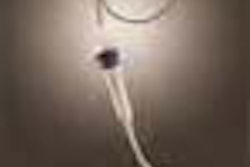At least five different imaging methods have been used to gauge suspected duct obstructions in male infertility, enough that one might wonder "Vas (the) deferens?" or even "Which technique works best?"
According to Dr. Refik M. Killi of the Ege University School of Medicine in Turkey, transrectal ultrasonography-guided echo-enhanced seminal vesiculography is the one to bet on, combining performance and safety at a lower cost.
"Distal ductal abnormalities, including congenital defects and obstructive disorders, are an infrequent cause of male infertility," Killi said in a presentation at the American Institute of Ultrasound in Medicine conference in San Francisco. However, identifying this 1%-2% of patients is important because "these cases are potentially correctable."
Turkish researchers used ultrasound with contrast as a less invasive way of evaluating the patency of the ducts, prostate, and urethra in 21 patients with suspected ejaculatory duct obstruction, Killi said. The contrast agent, known as SHU 508 A, is a saccaride-based, microparticulate-enhanced suspension manufactured by Schering of Berlin, Germany.
All of the patients were examined with microbubble echo-enhanced seminal vesiculography using the transrectal-ultrasound-guided seminal vesicle puncture technique. Each seminal vesicle was first identified on the axial plane, then punctured with an 18-gauge, 25-cm-long needle, which allowed an 11 ml bolus of contrast to be administered under real-time sonographic guidance. Patients received a cleansing enema and 400 mg of the antibiotic norfloxacin before the procedure.
"Patency of the ejaculatory duct was confirmed by visualizing the flow of contrast solution through the seminal vesicle, the vas deferens and the ejaculatory ducts, and passing through the prostatic urethra and bladder," Killi said.
Technical success was achieved in all 21 patients, with complete visualization of the vesicular structures. Anesthetics were unnecessary, Killi said, and patient discomfort was minimal. The researchers saw no major complications, and the few minor complications that occurred, including hematuria and hemospermia, resolved spontaneously, according to Killi.
Killi also summarized his view of other methods for confirming ejaculatory duct obstruction, including,
- Vasography. Although considered the gold standard, this procedure is expensive, invasive, and carries an unquantified risk of damage to vascular structures, Killi said.
- Cytoscopic cannulation of the ejaculatory ducts with radiography and infusion of x-ray contrast is "currently not used because of technical difficulties."
- MRI with endorectal coils "provides good detailed anatomical depiction of ejaculatory ducts, and is less operator-dependent than other modalities," Killi said, but its use is limited by cost and availability.
- Transrectal ultrasound (TRUS) is a cost-effective initial diagnostic modality, but patients with clinical findings of obstruction must still undergo vesiculography and testicular biopsy.
- TRUS-guided x-ray contrast seminal vesiculography can be performed on an outpatient basis without anesthesia, Killi said, and is less invasive and technically easier than vasography. However, radiation exposure and the need for x-ray contrast agents are two important disadvantages of the technique, he said.
By comparison, TRUS-guided echo-enhanced seminal vesiculography performed well while minimizing cost and maximizing safety, Killi suggested.
"The new method offers all the advantages of x-ray contrast with seminal vesiculography, (with) additional advantages including ease of examination, absence of radiation, no risk of allergy to x-ray contrast medium, ease, and availability of monthly follow-ups," Killi said. "Therefore we highly recommend this new technique for evaluating the suspected obstruction, and for the follow-up of patients with infertility problems previously treated by other methods."
By Eric Barnes
AuntMinnie.com staff writer
May 2000
Related Reading
"Transrectal US-guided seminal vesiculography," Radiology 1997 Oct;205(1):276-8
"Role of ultrasound in the assessment of male infertility," J Clin Ultrasound 1996 Oct;24(8):437-53
"Diagnosis of vasal obstruction with seminal vesiculography: an alternative to vasography in select patients," Fertil Steril 1995 Dec;64(6):1224-7
"Primary male infertility caused by congenital prostatic cyst: sonographic and MRI findings," Urol Int 1998 Oct;61(1):58-61
"Imaging of obstructive azoospermia," Eur Radiol 1997;7(7):1079-85
"MR imaging in male infertility," Radiographics 1997 May-Jun;17(3):627-37
"Antegrade ejaculatory duct recanalization and dilation," Urology 1995 Nov;46(5):743-6
"Ejaculatory duct obstruction in infertile men," BJU Int 2000 Apr;85(6):720-724
Let AuntMinnie.com know what you think about this story.

















